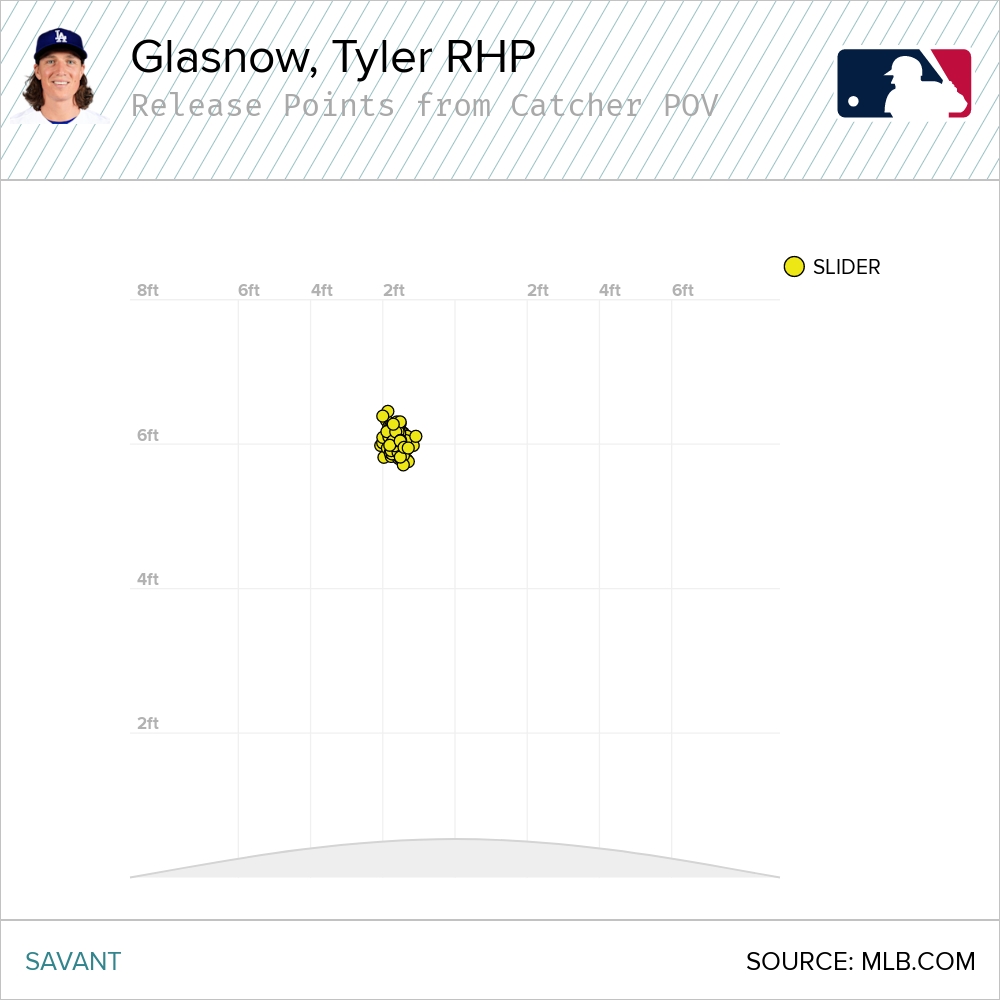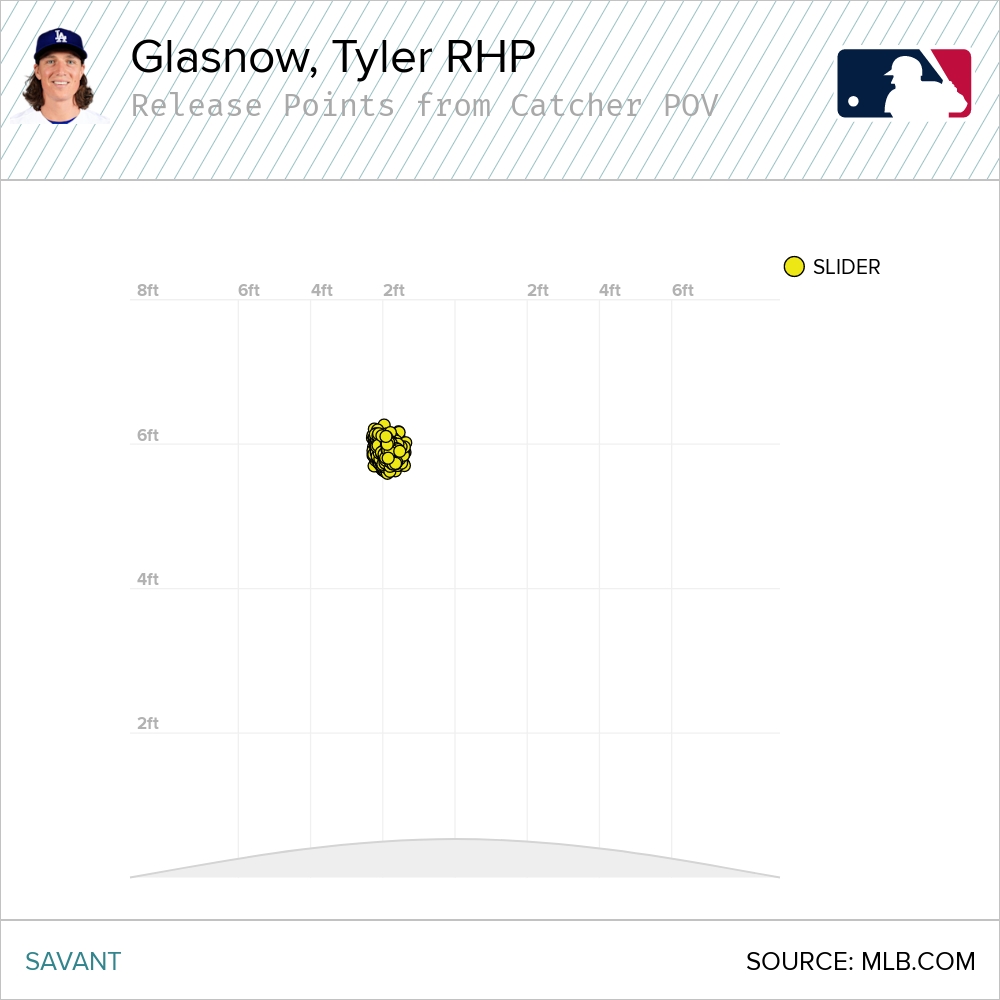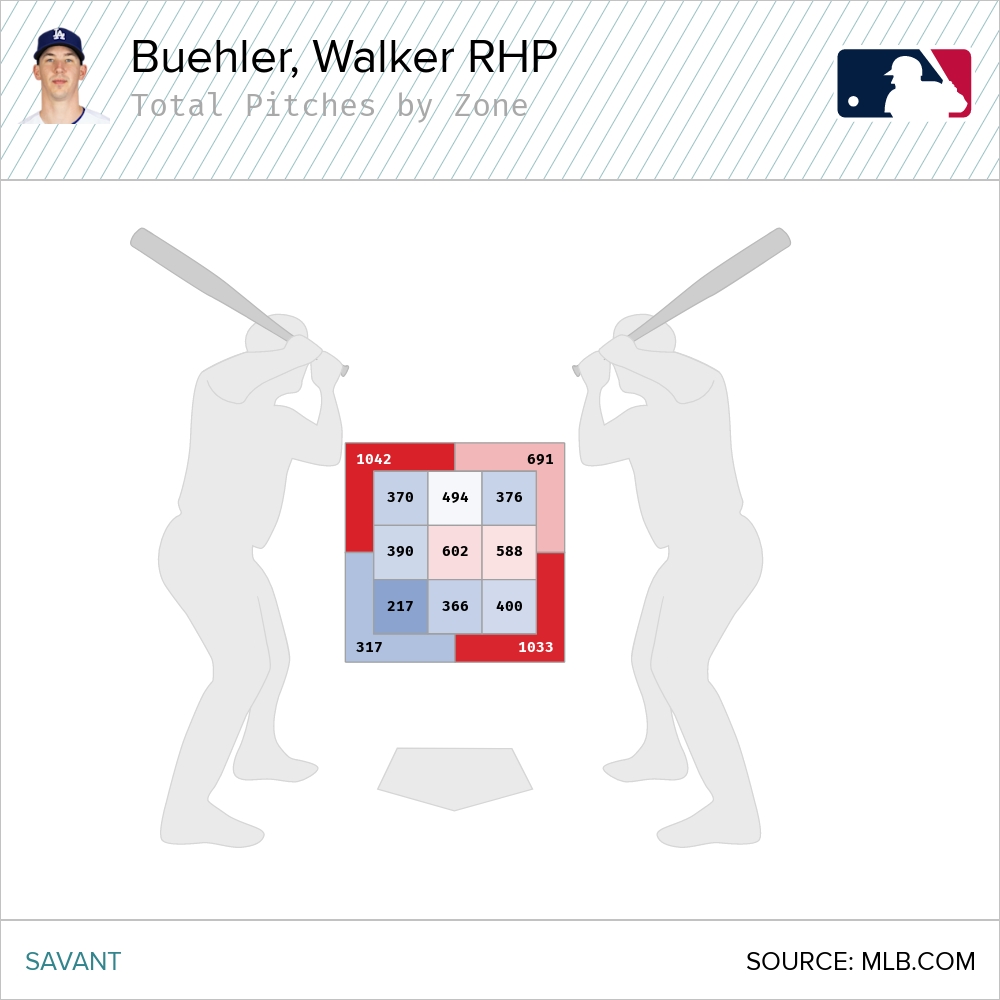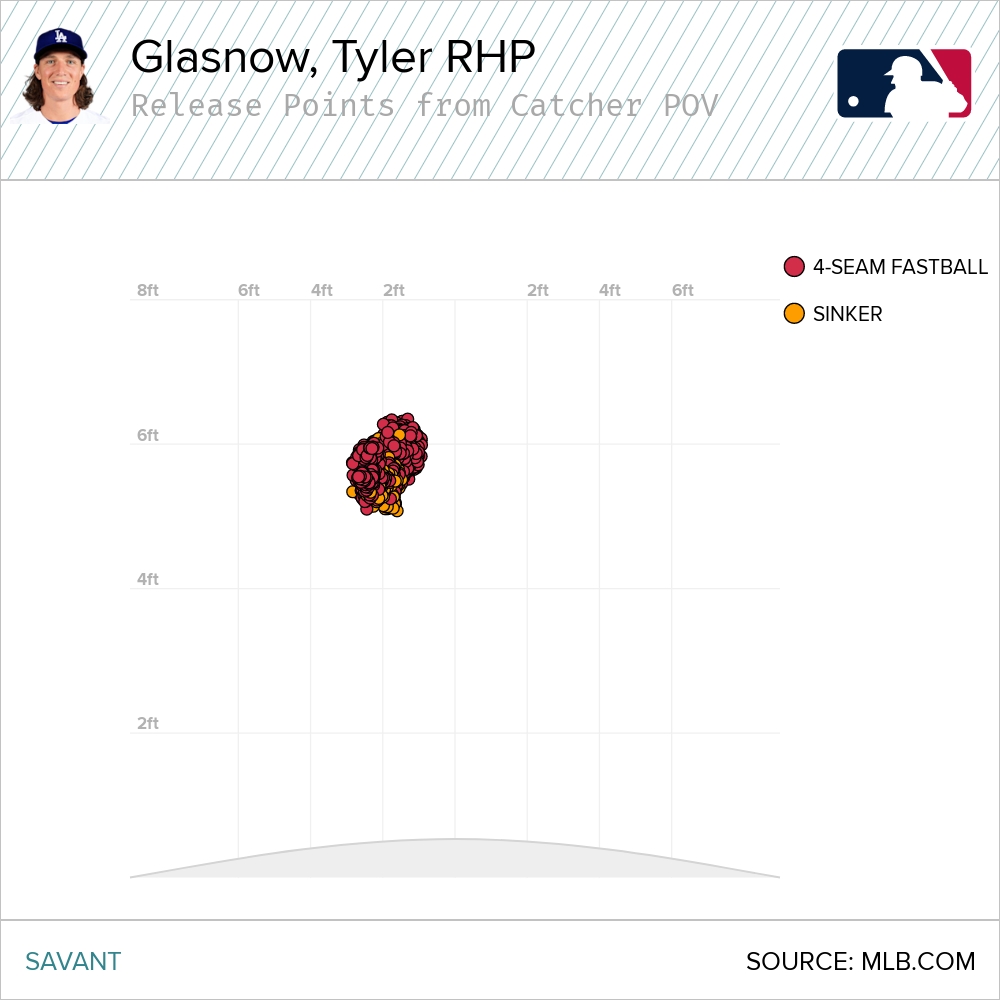When word first broke (by one of our very own, Bruce) of the package that was set to bring Tyler Glasnow to Los Angeles, folks were taken aback by the whole “five years of Ryan Pepiot for one year of Glasnow” thing. But even if Glasnow didn’t agree to a contract extension, it would have been a good deal for the Dodgers because Glasnow has some of the best stuff in the game, and isn’t dissimilar to a current pitcher on the roster.
So let’s take a deeper look at his stuff and why the Dodgers felt comfortable enough trading Pepiot and giving Glasnow a lucrative extension.
——
The first thing you immediately notice about Glasnow — besides his being 6-feet-8-inches tall — is his fastball. Since 2017, the average velocity on his heater is 96.8 MPH — 6th-fastest in MLB, sandwiched between his former teammate (and shoulda-been-Dodger) Shane McClanahan (96.9 MPH) and Luis Castillo (96.7 MPH). The 2023 Stuff+ rating of 128 was third-best among pitchers with 120 innings pitched — behind Spencer Strider (141) and Bobby Miller (130).
And not that a nearly 97 MPH needs any “play up,” but Glasnow’s does because of his 99th percentile extension of 7.5 feet. That’s Kenley Jansen territory and something to which Walker Buehler cannot lay claim. Mentioning Buehler and seeing the similarities between he and Glasnow isn’t by accident, either, because Glasnow might be Buehler’s replacement following the 2024 season.
Buehler is/was the hardest-throwing starter (96.2 MPH) the Dodgers have had during this current run (non-Dustin May/Miller division). Glasnow might actually be a taller version of Buehler, and the data seem to back it up. Here are Glasnow’s and Buehler’s zone profiles on their fastballs:
That’s eerily similar. They also have similar release points.
With Buehler set to hit free agency after the season, it’s no guaranteed that he’ll be re-signed. The Dodgers invested heavily in Shohei Ohtani, are in serious pursuit of Yoshinobu Yamamoto and are still on the periphery of guys like Corbin Burnes and Dylan Cease. I’m always going to say “not my money,” but at some point, ownership isn’t going to be OK with so many 9-figure deals, no matter how many championships they might win. Provided Buehler bounces back this season, he’s set for a big payday next winter — and it may or may not be with the Dodgers.
It may seem odd that the Dodgers would rather invest in Glasnow long-term than Buehler, but Glasnow provides more upside, which is saying something seeing as Buehler has been pretty damn good himself before an injury-riddled 2022 season.
——
Let’s stipulate that, unless noted, Glasnow and Buehler are pretty similar in everything that’s to follow here. While Buehler started to establish a cut fastball more in every season of his career (which cut into his 4-seam fastball usage), their arsenals are pretty identical — and it wouldn’t be surprising to see Glasnow tinker with a cutter once Mark Prior and Co. get him into the fold.
Along with his fastball, Glasnow has a devastating curveball and a slider that he seems to like despite suboptimal results. The curveball has been absolutely unhittable. He has a batting against line of .140/.171/.271 against it in his career, with a .189 wOBA. He also has an 86 MPH exit velo against it. That’s actually markedly better than Buehler’s curveball metrics (.216/.238/.346, .249, 88.8). Glasnow throws it 19.4% of the time, but he hasn’t been overly consistent with the usage.
| Year | CB Usage (%) |
| 2017 | 22.7 |
| 2018 | 17.5 |
| 2019 | 29.3 |
| 2020* | 34.8 |
| 2021 | 13.5 |
| 2022** | 18.4 |
| 2023 | 21.3 |
*COVID-19-shortened season
**Threw 6 2/3 innings after recovering from Tommy John surgery
So, consistency is something Glasnow and the Dodgers could look to improve, especially since it had the 4th-best Stuff+ rating of 152 with the pitch this past season.
He also has a slider that he first added in 2018, dropped in ’19 and ’20 before picking it back up again in ’21. In ’21 and ’23, he threw it 32.3% and 34.8% of the time with not great results. Overall, he allowed a .236/.276/.389 batting line against with a .287 wOBA and a 90.9 MPH EV against. He throws it hard (91.5 MPH average velo in 2023), so the fact that it relies so much on vertical movement to be effective is strange. He saw it lose eight inches of vertical drop from ’21 to ’23, which resulted in poorer results.
| Year | BA | OBP | SLG | wOBA | Velocity (MPH) | Usage% |
| 2021 | .197 | .232 | .424 | .277 | 87.5 | 32.3 |
| 2023 | .254 | .296 | .373 | .292 | 90.1 | 34.8 |
It’s weird. He got touched up a bit in 2021 by allowing four homers and three doubles when using his slider — in just 69 plate appearances ending with the slider. In ’23, it was four homers and five doubles in 154 plate appearances. He saw his release point dip a bit last season when compared to ’21 and ’18, when it was its most effective and least-thrown — 10.2% usage, .074/088/.118 batting line against with a .107 wOBA and 88.3 MPH EV against.



It seems he either needs to learn the sweeper, have his current slider tweaked or reduce the usage overall — or some combination of all three — if the recent results are what’s going to come from it.
——
Something Glasnow definitely needs some help with is limiting hard contact and minimizing exit velocity. He was in the bottom 15% of the league last year and has only been near the Top 80% once — 2019, when he threw just 60 2/3 innings. Luckily for Glasnow and the Dodgers, limiting hard contact is a teachable skill, mainly through pitch mix. In the Statcast era (2015-present), the Dodgers have had the best exit velocity against numbers for an entire pitching staff at 87.5 MPH. The only other team to have a sub-88 MPH exit velocity against mark is the Brewers (87.7 MPH).
Again, the similarities between Buehler and Glasnow are evident. In his best seasons (2019 and 2021), Buehler was in the 63rd- and 64th-percentile, respectively, when it came to exit velo against. So, the Dodgers have proven they can not only improve a pitcher’s exit velocity against numbers, but also help the pitcher be successful even if he doesn’t have 90th percentile numbers across the board. That bodes well for Glasnow’s future.
Finally, he has similarity scores of a couple pitchers the Dodgers are familiar with — 2020 Buehler (obvi) and 2021 Cease, in whom they still have interest. As far as batted ball profile, he compares similarly to 2018 Garrett Richards (a guy I’m surprised hasn’t ever been a Dodger despite interest) and a couple old friends in the 2017 versions of Mike Bolsinger (!) and Tom Koehler. The fact that the Dodgers went after him shouldn’t really be surprising.
——
We’ll see how the rest of the offseason plays out, but acquiring Glasnow and extending him is a big gamble on his health and the Dodgers’ ability to keep him healthy, but it’s also a type of safeguard against losing Buehler next winter. They’re such similar pitchers that it’s kinda hard not to envision the Dodgers feeling the same way.
 Dodgers Digest Los Angeles Dodgers Baseball Blog
Dodgers Digest Los Angeles Dodgers Baseball Blog




